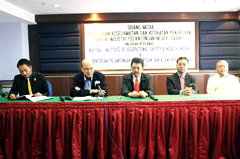New Sabah Times, 29th August, 2012
KUNDASANG: Although the country’s industrial accident rate has been halved in the past 10 years, there is still a need to build and foster an occupational safety and health (OSH) culture and strive towards an accident-free workplace environment.
Speaking at a press conference after the launching of an OSHseminar for the tourism industry in Sabah here yesterday, National Institute of Occupational Safety and Health (NIOSH) chairman Tan Sri Lee Lam Thye said the latest statistics from the Ministry of Human Resources should that the industrial accident rate had fallen from 10.3 cases for every 1,000 workers in 2002 to 5.72 cases last year.
He said this reflected the commitment and joint efforts by the government, employers and employees to reduce workplace accidents.
“While we are pleased to note the success of the joint efforts by all parties concerned, the biggest challenge remains that we only should further reduce the accident rate but also to build and foster an OSH culture in Malaysia.
“For a start, we need to benchmark ourselves against the developed countries which only have 3-4 accidents per 1,000 workers,” he said.
The Occupational Safety and Health Master Plan 2010-2015, he stressed, must be given utmost attention by all parties concerned to achieve further reduction in the rate of industrial accidents.
Lee also said companies must not profit at the expense of safety because if accidents occurred, lives may be lost and productivity would be affected.
“AS such, OSH ownership in every organisation is of paramount importance,” he said, adding that the focal point of safety was the human being or the employee who needed protection.
An accident prevention coupled with an OSH management strategy should therefore be adopted by all companies.
And, to achieve the total promotion of safety and health at work and elsewhere, organisational measures for accident prevention, motivation and behavioural change must be adopted.
Lee added that it was the responsibility of management to ensure that safety became a culture at their organisation and not just a priority.
“There is an urgent need to translate OSH knowledge into behaviour and practical application. OSH sloganeering is not the answer. We must avoid a situation where behind all the OSHbanners and signages, the workplace hazards are not addressed and controlled,” he said.
In this time of global competition and sweeping change, it is not enough for companies to make safety a priority.
Priorities change but cultures stand the test of time and safety must be a culture and a core value at the workplace.
He said managing occupational safety and health towards business competitiveness was very important and that employers must see training as an investment and not an expense.
“Management or employers must recognise the OSH of employees as an integral part of business management.
“Concerns for the bottom line must be looked at with equal gravity with OSH issues at the workplace. After all they are both concerned with the viability of the business enterprise,” he said.
Lee also said employees were often regarded by management to be the most important asset of any organisation.
“Hence, it makes sense that this particular asset should be protected in terms of health and safety and nurtured to ensure that it continues to be productive,” he said.
Management, he said, must now take a hard look at their asset and actively show how much they valued their employees with a responsible OSH policy backed up by the necessary organisation and system to implement accident prevention programmes.
“Common sense tells us that “safety is good business”. If industries give priority to safety issues at the workplace it will certainly be beneficial to the business,” he said.
The seminar was opened by Kundasang Assemblyman Dr Joachim Gunsalam on behalf the Minister of Tourism, Culture and Environment Dsatuk Masidi Manjun.
Also present were NIOSH Sabah regional manager Mohd Hussin Salam, Tourism Ministry’s permanent secretary Datuk Michael Emban and Ranau assistant district officer Bernard Kimin.

Lee (2nd left), flanked by Hussin (left) Dr Joachim (3rd left), Michael and Bernard (right) at the press conference










